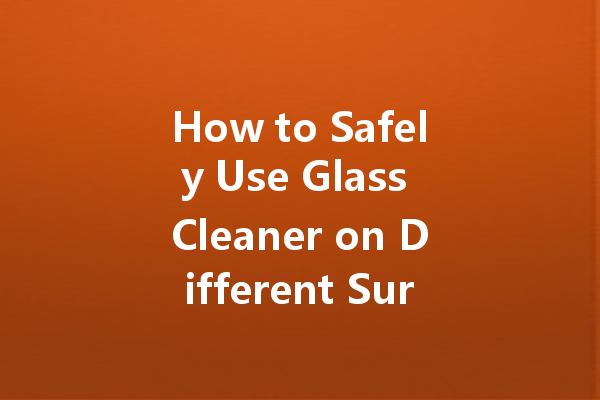Introduction
When it comes to cleaning our homes, glass cleaner is a versatile and essential tool. However, using it on different surfaces requires a nuanced approach to ensure effectiveness without causing any damage. In this article, we will explore the best practices for safely using glass cleaner on various surfaces in your home.
Choosing the Right Glass Cleaner
Before delving into the specifics of cleaning different surfaces, it’s crucial to start with the right glass cleaner. Look for products that are specifically designed for the surface you intend to clean, whether it be windows, mirrors, countertops, or electronic screens. Additionally, opt for non-toxic and environmentally friendly options to minimize exposure to harsh chemicals.
Glass Surfaces: Windows and Mirrors
Glass cleaner is commonly used on windows and mirrors to achieve a streak-free shine. When cleaning windows, start by dusting or vacuuming the sills and frames to remove any loose debris. Spray the glass cleaner generously on the surface and wipe it off with a microfiber cloth in a vertical or horizontal motion to avoid streaks.
For mirrors, apply the glass cleaner sparingly to avoid drips and streaks. Use a clean, lint-free cloth to buff the mirror to a sparkling finish. Avoid spraying the cleaner directly on framed mirrors to prevent damage to the frame.
Electronics: Screens and Monitors
Using glass cleaner on electronic screens requires extra caution to prevent damage. Always refer to the manufacturer’s instructions for cleaning the specific device. Before applying the cleaner, turn off the device and unplug it from power sources. Spray a small amount of glass cleaner onto a microfiber cloth and gently wipe the screen in a circular motion. Avoid using excessive pressure to prevent scratches.

Countertops and Glass Tabletops
When cleaning glass countertops and tabletops, be mindful of any decorative finishes or coatings that may be sensitive to certain chemicals. Opt for a mild glass cleaner or a homemade solution of water and vinegar for non-porous surfaces. Spray the cleaner on the surface and wipe it down with a soft cloth or sponge. Avoid abrasive materials that could scratch the glass.
Vehicles: Windshields and Car Windows
For cleaning car windows and windshields, choose a glass cleaner specifically formulated for automotive use. Avoid ammonia-based cleaners that can damage tinted windows. Spray the cleaner on the glass and use a microfiber towel to wipe away dirt and grime. Pay special attention to the edges of the glass where dirt tends to accumulate.
Outdoor Glass: Patio Doors and Furniture
Outdoor glass surfaces like patio doors and furniture require regular cleaning to maintain their appearance. Use a glass cleaner suitable for outdoor use to remove dirt, pollen, and other outdoor debris. Spray the cleaner on the glass and wipe it off with a soft cloth or sponge. Be mindful of surrounding landscaping to avoid chemical runoff.
Conclusion
Safely using glass cleaner on different surfaces in your home is essential to maintain cleanliness without causing damage. By following the tips outlined in this article, you can ensure that your windows, mirrors, electronics, countertops, vehicles, and outdoor glass surfaces remain sparkling and free from streaks. Remember to choose the right cleaner for each surface and always read and follow the manufacturer’s instructions for optimal results.
